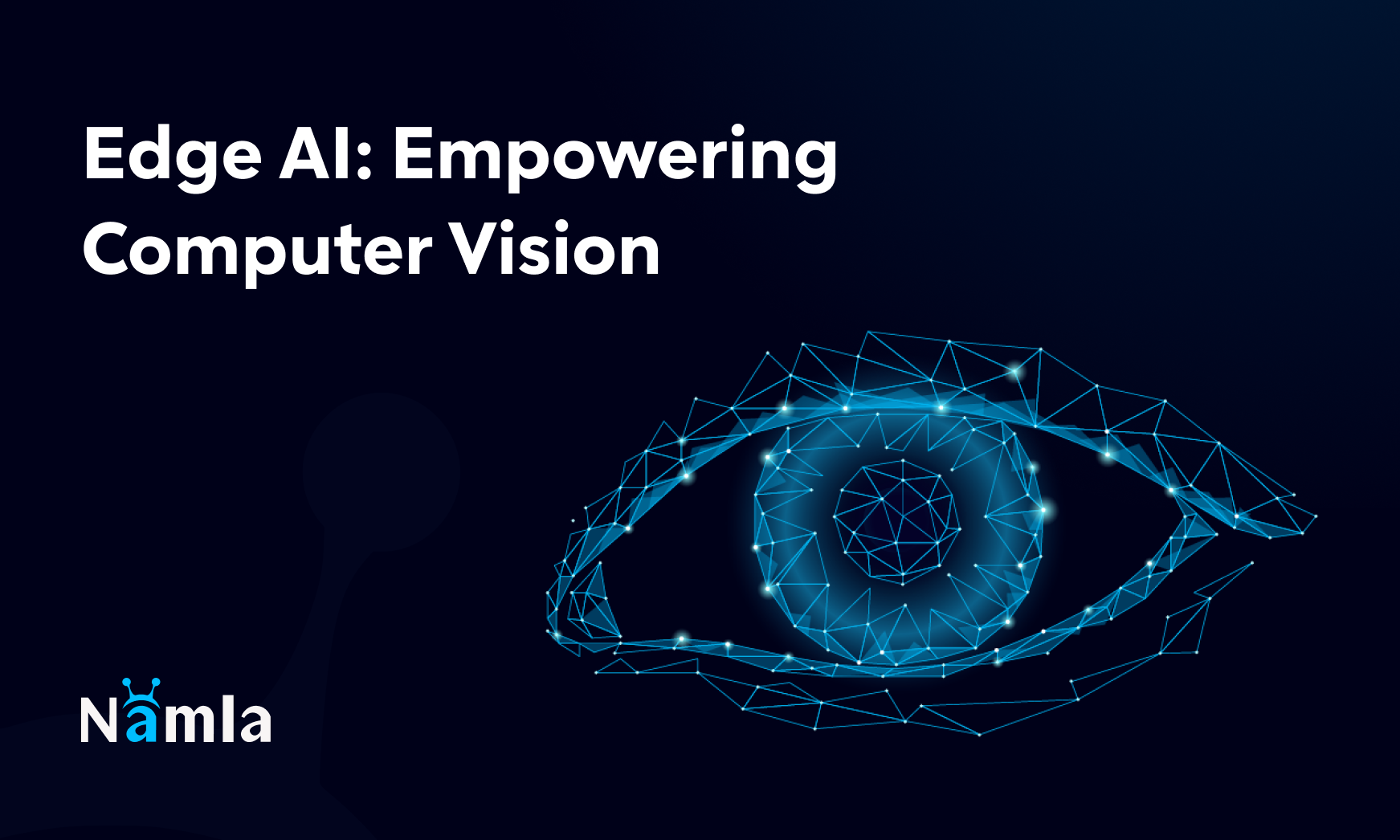Edge AI: Empowering Computer Vision

Published on April 17, 2023

Ready for a demo of
Namla
?
The widespread availability of the internet and advancements in technology have resulted in machines handling numerous computation-based tasks through either pre-programming or artificial intelligence. This resulted in increased efficiency, eliminating the need for programming and saving time and resources.
The adoption of artificial intelligence has impacted various industries, resulting in changes in the way tasks are performed, which changed the global industry’s direction towards a new future that incorporated AI in one form or another. Parallel to the AI revolution, software solutions are also witnessing a transformation in terms of their development and deployment. The emergence of edge computing, which involves processing data locally on a device rather than sending it to a remote server, has opened up new opportunities for companies to explore and potentially change their approach to fit with edge technologies.
Tech companies have targeted many fields with similar objectives; either to reduce human intervention and automate non-automated tasks by mimicking human intelligence, or to overcome the limitations of heavy computations and identify patterns that traditional programming cannot.
This article will focus on one of these fields, computer vision, and its integration with edge computing. We will discuss the impact of combining these technologies on various industries and examine some of the existing market solutions in use in different sectors that utilize edge AI and computer vision.
What’s Edge AI ?
Edge AI computing refers to the use of artificial intelligence (AI) algorithms on devices located at the “edge” of a network, such as sensors, cameras, and other Internet of Things (IoT) devices. Processing and analyzing data in real-time on these devices, leaves no need to send data to a centralized server.This results in faster decision-making, reduced latency, and improved data privacy and security.
What’s Computer Vision ?
Computer vision can be described as the process of teaching a computer to analyze visual data in a similar way to how the human brain does. In its early development, the purpose of computer vision was to mimic human visual capabilities with the goal of allowing robots to “see.” However and over time, programmers found a number of other uses for it. The accomplishments of computer vision can be attributed to its popularity within the deep learning community.
What are the main benefits of using Edge AI in computer vision ?
- Real time video processing and streaming
Edge AI enables the processing of video frames without the need to send the entire video to a server.
- Resolves big data processing concerns
Due to the high rate of data transmission in video processing and the sensitivity of visual data during continuous learning of models, the use of edge AI with its high availability, bandwidth, and throughput can address these concerns.
- Greater reach and faster response times
Edge computing has no dependency on a central data center or network bandwidth, allowing for computer vision operations in remote locations that lack the necessary network infrastructure and providing faster response times.
- Reduced risk and improved privacy
Edge AI distributes the risk of exposure across multiple devices and can perform all processing disconnected from a central server, resulting in an even more secure and private architecture.
- Significantly less expensive
Computer vision is a powerful technology, but it can be complex and expensive to build, deploy, and maintain. For example, cloud companies charge for inferencing per endpoint, per minute. This may be beneficial for organizations that want to pay on an “as needed” basis; however, it can become burdensome for organizations that require large amounts of real-time processing - such as a smart city or hospital with many cameras and sensors running 24 hours a day.
- Reduced latency
This is particularly important for real-time projects that implement computer vision and AI, such as robotic surgery, autonomous driving, and human fall detection.
What are the main use cases of Edge AI in Computer vision ?
- Retail
Edge computer vision and edge AI can be used for various purposes, from shop assistants to customer behavior analysis towards specific products or for security measures using smart cameras on the retail floor. The main objective of using edge computer vision is to learn and understand shoppers’ interests and and leverage visual data found on the edges to improve the business.
- Healthcare
Time and data privacy are essential and represent the core of the industry right after saving lives. Incorporating edge computer vision and edge AI is ideal because it provides real-time inference without access to external servers. This guarantees a high level of data security and faster response times.
- Manufacturing
Factories deploy security cameras across various floors. With computer vision, these devices can double their potential by automatically monitoring operations while tracking real-time hazards with alert automation.
- Construction
As an industry with the highest mortality rate, edge-based computer vision offers constant monitoring of construction sites. It can identify unsafe zones and restrict workers from entering, monitor heavy vehicle movement, and identify rule violations.
- EdTech industry
Edge AI and edge computer vision can both benefit educational systems worldwide by addressing student data privacy concerns and providing personalized learning experiences for students to enhance their skills. The use of edge technology also makes any kind of solution a viable option regardless of internet speed, thanks to the ability to perform local computations.
What are the main challenges to implement Edge AI for Computer Vision ?
Edge computer vision might seem like a fancy solution to current tech industry challenges, there are, however, several challenges can arise at different levels when developing and deploying edge-based computer vision solutions in industries. These challenges can vary depending on the industry, use case, and the complexity of the solution. Here are some common challenges that may arise:
- Data Management
Companies are required to have the right infrastructure and tools to store, process, and manage the data used by the solution due to the large amount of data transmitted and generated in edge-based AI or computer vision.
- Technical Expertise
It can be very challenging to build a team with expertise in all machine learning, edge computing, computer vision, and knowledge of the industry business when developing edge AI-based solutions. Different levels of expertise and knowledge are required for each different industry.
- Orchestration & Management
Edge AI is a shift paradigm from the traditional centralized architecture used in the cloud to a decentralized architecture used in Edge computing. This represents a reel challenge from deployment point of view. Solution to handle the deployment of Edge computing boxes are needed to make the experience of companies using Edge AI as simple as reliable as the use of cloud computing.
- Integration with existing systems
It is crucial to integrate edge-based computer vision with existing systems to ensure seamless operations. Companies, however, may face several difficulties and challenges when integrating these solutions with legacy systems or systems from various vendors.
- Environmental factors
Edge-based computer vision solutions rely on the availability of reliable network connectivity and power sources. For certain industries, such as agriculture or mining, these factors may give rise to several challenges that need to be addressed to ensure the effective deployment and operation of these solutions.
- Cost
Deploying edge-based computer vision solutions require a significant investment amount in hardware, software, and infrastructure. Organizations need to assess the costs and benefits of deploying these solutions and ensure that they align with their business objectives.
- Privacy and Security
Privacy and Security: Adding edges to AI and computer vision solutions can provide an additional layer of security to protect data, failing to secure the edges against breaches and external access can make the use of edges a vulnerability in the system. One challenge that can arise when deploying edge-based solutions is securing the data.
Examples of Edge Computer Vision Industry Solutions
Due to the efforts spent on academic and professional research into computer vision solutions, more companies in different industries are considering incorporating these solutions into their businesses. Edge computing has proved its effectiveness as method for implementing computer vision solutions in various industries. Here we present some industries that have implemented edge computer vision:
- Retail some existing solutions in the market include:
- Zippin - Computer vision and machine learning are used to enable a seamless shopping experience.
- BossaNova - Bossa Nova is a provider of shelf-scanning robots that use computer vision and machine learning to monitor store shelves and inventory.
- NVIDIA Metropolis - NVIDIA Metropolis is an edge-to-cloud platform that provides retailers with a range of AI-enabled solutions, including computer vision, video analytics, and deep learning.
- Healthcare some solutions that are experiencing growing adoption in the healthcare industry include:
- NVIDIA Clara - NVIDIA Clara is an AI-enabled platform that provides healthcare organizations with a range of edge computing solutions, including medical imaging, genomics, and drug discovery. The platform uses powerful GPUs to accelerate the processing of medical data, enabling healthcare providers to quickly analyze large datasets and make more accurate diagnoses.
- Niramai - Niramai is a breast cancer screening solution that uses edge computing and thermography imaging to detect tumors. The system uses machine learning algorithms to analyze thermography images in real-time, detecting potential abnormalities that could indicate the presence of cancer. By using edge computing, the system can provide faster and more accurate results, enabling healthcare providers to diagnose and treat cancer earlier.
- Manufacturing
- Sight Machine - The platform relies on edge computing and computer vision to provide real-time and detailed insights into manufacturing processes through the use of advanced machine learning algorithms.
- Osprey Informatics is a platform that uses edge computing and computer vision to provide real-time monitoring of industrial sites. System data is collected using sensors and cameras which is then real-time analyzed using machine learning algorithms.
- Construction
- HoloBuilder is a construction technology platform that uses edge computing and computer vision to provide 360-degree photo documentation of construction sites.
- Newmetirx is a construction technology platform that uses edge computing and computer vision to analyze construction site images and videos for safety and quality issues. The system uses advanced computer vision algorithms to recognize safety hazards and quality issues and provide real-time alerts to project managers.
- Edtech industry
- Osmo is an educational platform that uses edge computing and computer vision to provide personalized learning experiences for children. The system uses a combination of physical objects and digital games to help children learn. Computer vision is used to recognize and respond to the child’s movements and actions.
- Zspace - A platform providing immersive learning experiences for students. Virtual and augmented reality technologies are used to create interactive learning environments in addition to computer vision to to track student’s movements and actions. The system then provides real-time analysis and feedback thanks to edge computing, enabling students to learn in a more engaging and interactive way.
- Moxie Reader - Edge computing and computer vision are used to provide personalized reading comprehension support for students. The platform uses advanced machine learning along with edge computing to analyse students’ reading level and provide personalized feedback and support, in real-time, allowing students to improve their reading comprehension skills.
What Namla propose for Edge Computer Vision Industry?
Implementing an Edge AI solution for computer vision is very challenging, especially when it comes to deployment & management. Namla as a Cloud-Edge management and orchestration platform helps compagnies, looking for the use of Edge AI in the field of computer vision, to seamlessly deploy these solutions.
Namla delivers an All-In-One platform that allows:
- Zero Touch Deployment: for a Plug & Play Edge deployment.
- Cloud native SDWAN: for a secure and reliable network.
- Applications Orchestration: for a seamless AI models deployment & management.